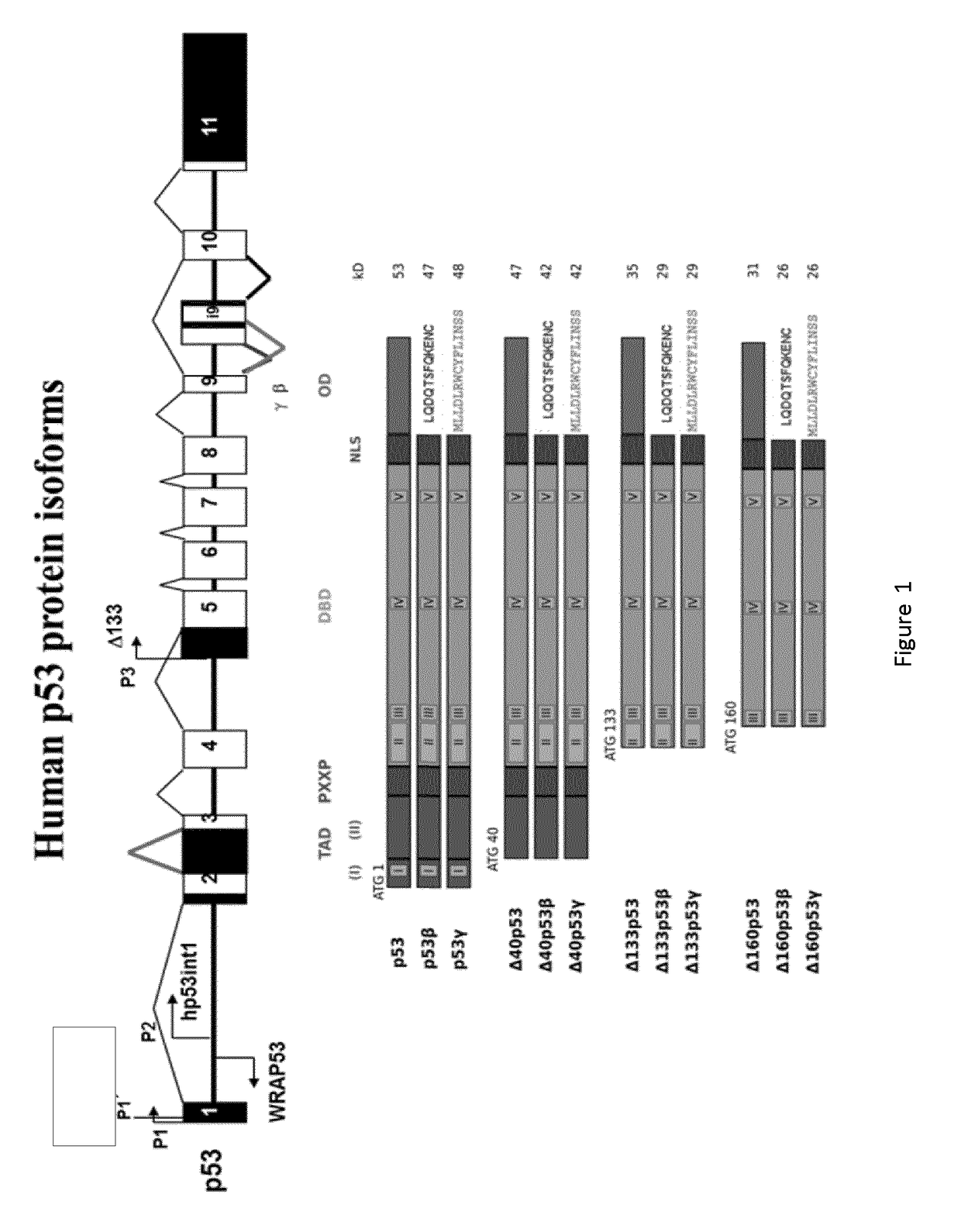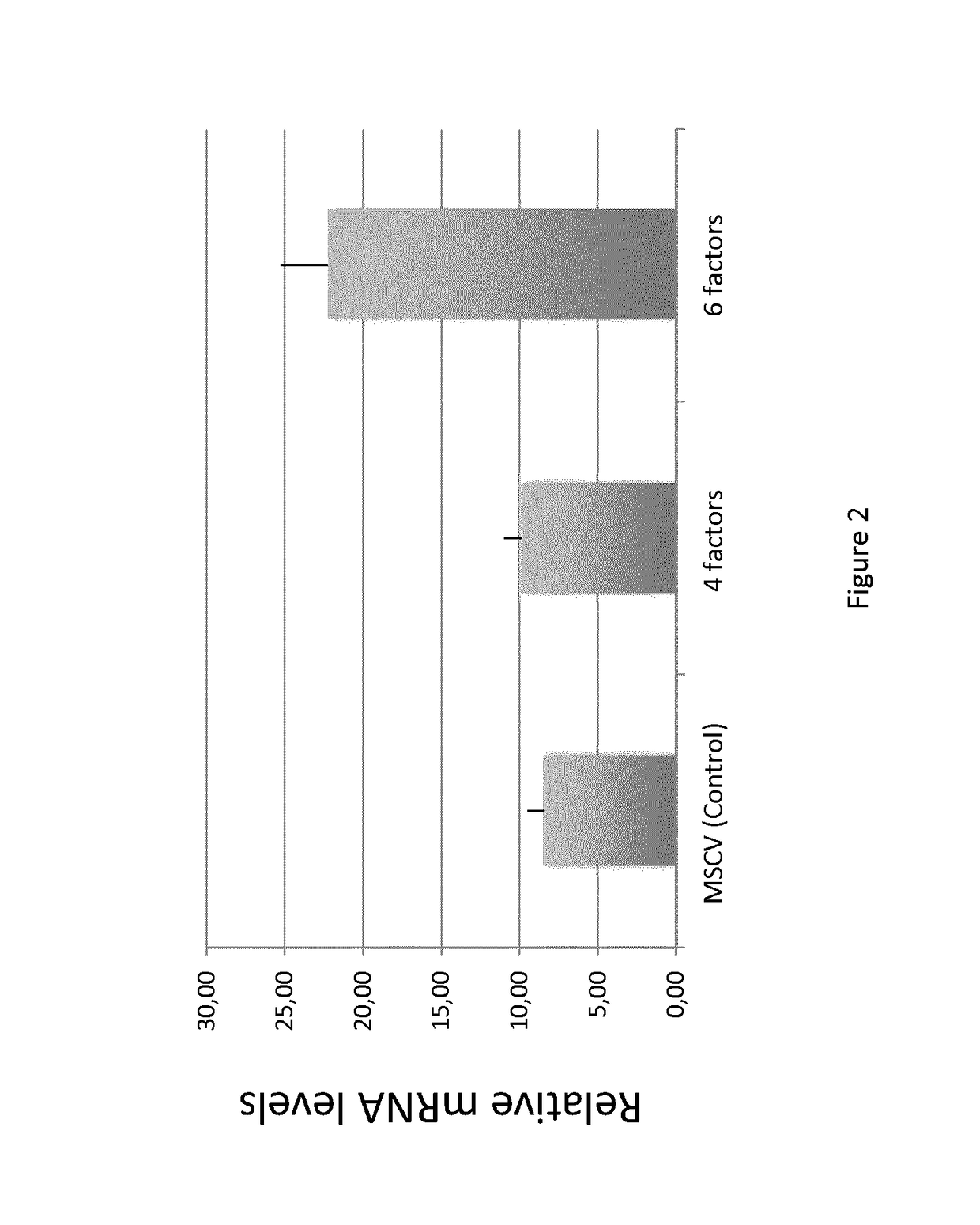Reprogramming Method for Producing Induced Pluripotent Stem Cells (iPSC)
a pluripotent stem cell and reprogramming method technology, applied in the field of cell biology, can solve the problems of low reprogramming efficiency, uncertain stability of derived pluripotent stem cells, hampered medical applications of embryonic stem cells, etc., and achieves the effects of preserving genetic stability, increasing reprogramming efficiency, and altering dna repair mechanisms
- Summary
- Abstract
- Description
- Claims
- Application Information
AI Technical Summary
Benefits of technology
Problems solved by technology
Method used
Image
Examples
example 1
is Highly Expressed in ES and iPSC Compared to Dedifferentiated Cells
[0174]The experimental protocol described above was used herein. Furthermore, 4 transcriptional factors (Oct4, Sox2, Klf4, c-myc) or 6 transcriptional factors (Nanog and Lyn28 in addition of the 4 factors) were added.
[0175]To analyze how human pluripotent stem cells adapt p53 alternative splicing during induction, maintenance and differentiation, Δ133p53β mRNA levels were analyzed by qPCR in iPSCs induced from fibroblasts with 4 factors (Oct4, Sox2, Klf4, c-myc) or 6 factors (Nanog and Lyn28 in addition of the 4 factors) after 3 weeks of reprogramming.
[0176]Generally, forced expression of the 4 factors Oct4, Sox2, Klf4 and c-myc is necessary and sufficient to generate iPSCs from non-senescent cells. However, it is already known that senescent and centenarian-derived pluripotent stem cells redifferentiate into fully rejuvenated cells only when Nanog and Lyn 28 are added to the four-factor combination (Lapasset et al...
example 2
Reprograms Fibroblasts into iPSC
[0179]Human primary fibroblast cells were established from normal human foreskin and display a maximum of 72 population doublings before the onset of senescence. As shown on FIG. 5, Δ133p53β splice isoform of p53 produces iPSC-like cells, which express key regulators of pluripotency (FIG. 4).
[0180]Thus, it was chary demonstrated that herein used fibroblas are untransformed normal primary fibroblast.
example 3
ssion of Δ133p53β Isoform Preserves the Ability of Cells to Repair DNA
[0181]p53 is a limiting factor in iPSC reprogrammation from normal cells and it is also considered that the alteration of p53 expression during the reprograming somatic cells to iPSC could lead to the formation of iPSC containing DNA damage and / or chromosomal abnormalities. To ascertain the expression of Δ133p53 isoforms do not affect the DNA damage and DNA repair response, the inventors have tested the transactivational function of p53 in normal fibroblasts expressing Δ133p53α isoform or Δ133p53β isoform in the presence of DNA breaks caused by a radiomimetic agent (bleomycin). Previous studies conducted by the inventors showed that normal fibroblasts stop their cell cycle in the presence of DNA breaks via the accumulation of p21WAF-1, which is an inhibitor of cyclin dependent kinases, (Baus et al, EMBO J. 2003; Gire et al, EMBO J. 2004, Jullien et al, NAR 2013).
[0182]Normal fibroblasts transduced by a construct e...
PUM
| Property | Measurement | Unit |
|---|---|---|
| stability | aaaaa | aaaaa |
| genetic stability | aaaaa | aaaaa |
| genomic stability | aaaaa | aaaaa |
Abstract
Description
Claims
Application Information
 Login to View More
Login to View More - R&D
- Intellectual Property
- Life Sciences
- Materials
- Tech Scout
- Unparalleled Data Quality
- Higher Quality Content
- 60% Fewer Hallucinations
Browse by: Latest US Patents, China's latest patents, Technical Efficacy Thesaurus, Application Domain, Technology Topic, Popular Technical Reports.
© 2025 PatSnap. All rights reserved.Legal|Privacy policy|Modern Slavery Act Transparency Statement|Sitemap|About US| Contact US: help@patsnap.com



